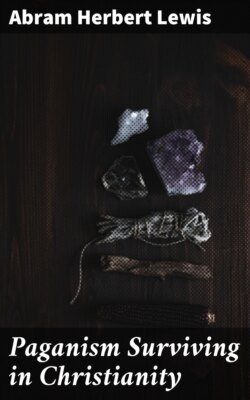Читать книгу Paganism Surviving in Christianity - Abram Herbert Lewis - Страница 6
На сайте Литреса книга снята с продажи.
CHAPTER II.
PAGAN METHODS OF INTERPRETING THE SCRIPTURES.
ОглавлениеTable of Contents
Contrast between the Christianity of the New Testament and That of the Later Centuries—Gnosticism and Allegorical Interpretation—Testimony of Harnack and Bauer Concerning the “Hellenization of Christianity”—Hatch on “Pagan Exegesis”—The “Fathers” as Allegorists; Justin, Clement of Alexandria, Barnabas, and Others—Examples: “The Red Heifer a Type of Christ”; “Spiritual Circumcision”; “Scriptural Significance of Foods”; “The Cross in the Old Testament”; “Why Are There One Hundred and Fifty Psalms?” “The Phœnix a Type of the Resurrection”; “Gnostic Exposition of the Decalogue”; “Types of Christ”; Various Examples from Augustine.
The student of history cannot fail to note the wide difference between the Christianity of the New Testament period and that of the fourth century. The religion which Christ taught was a direct outgrowth of Judaism. His mission was “not to destroy but to fulfil.” This He did by giving a higher conception and a broader view of all which Judaism had held hitherto. He gave a new meaning to the fatherhood of God. He explained and enforced the moral precepts of the Old Testament, developing their deeper spiritual sense, and giving them a new application to the inner life of men. He enlarged Judaism without destroying it. He clarified and intensified the ten commandments. He discarded the outward formalities of the Jews, and “reached the heart of things” by His interpretation of the ancient Scriptures, by His new precepts, and by His example. He developed Christianity within the Jewish Church, making it the efflorescence of all that was best in the ancient dispensation.
Christ presented love for God, for truth, and for man, as the mainspring of action in all religious living. Under His teachings Christianity arose as a new life, springing from the law of God, written in the hearts of men. New Testament Christianity was a life born of love, and finding expression in loving obedience. It was a system of right living, as in the divine presence, and by the help of the divine Spirit. Men were drawn to each other and to Christ by the power of this love. Such was Christianity at its birth.
The earliest Christian congregations were communities for holy living, upon the ground of a mutual faith in Christ. They expected still greater revelations of Him, and through Him, in the near future. The facts connected with His life and the memory of His teachings formed the soil in which Christianity had its earliest roots. A common hope and the struggle for holy living according to the law of God bound these communities together. They were made up of Jews alone, or of Jews and those Gentiles who had been converts to Judaism. Beyond this common hope there was no settled doctrine, no formal ecclesiastical organization. There were no written scriptures except the Old Testament. As the history of Christianity progressed, its enlarging spirit brought about a conflict with the narrower phases of Judaism, and hence more or less antagonism towards certain Judaistic interpretations of the Old Testament.
The Christianity of the third and fourth centuries presents the strongest possible contrast when placed alongside of that which existed during the New Testament period. The Sermon on the Mount was the promulgation of a new law of conduct. “The Nicene Creed is a statement partly of historical facts, and partly of dogmatic inferences.”[25] Some adequate reason must be found for this difference. How did this change in the central character of Christianity come to pass? By what influences was it transformed from a system of right living to a system of metaphysical belief; to right thinking rather than right doing? The answer is suggested by the fact that this change in character is contemporaneous with the transferring of Christianity from Semitic to Greek influence. Thus we are brought to face the fact that the religion of a given people at a given time bears certain definite relations to the mental attitude of that time. Religion is a part of common life which cannot be separated from its surroundings. While we may consider religious problems as distinct from other questions, they can never be understood except as a part of the complex life with which they are interwoven.
We therefore must commence by inquiring after the characteristics of the pagan world into which the infant Christianity passed when the stream of its history left the soil of Palestine and entered the field of Greek and Roman influences.
